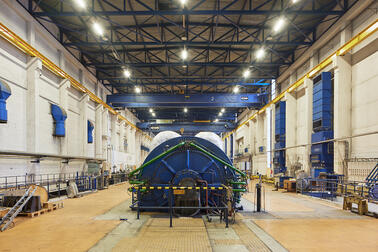Based on a series of surveys carried out, the City has come to the conclusion that the Hanasaari power plant building could be preserved and put to new use in the future. The prospects of reusing the building will now be surveyed in more detail.
“At its best, this architecturally interesting industrial milieu in a central location could provide significant potential from the perspective of the entire city. There are several examples around the globe of old power plants that have been developed into highly attractive locations. Helsinki is now thoroughly surveying the opportunities provided by Hanasaari,” muses Design Director Hanna Harris from the City of Helsinki.
The future use of the power plant has not been decided on yet. The City will commission surveys with the purpose of obtaining additional information and establishing whether the power plant building can be preserved as part of the further development of the area. It has already been established that the soil of the area presents a challenge. The condition of the foundation and other structures of the building will also be inspected further.
“If these upcoming surveys indicate that reusing the power plant is technically and financially feasible, a competition may be held to determine its future use. We are also surveying the prospects for temporary use of the power plant,” explains Project Director Päivi Hietanen from the City’s Urban Environment Division. Hietanen is responsible for planning the power plant’s further use.
Helen is investing in carbon-neutral production in the Energy Block
Hanasaari power plant was designed by architect Timo Penttilä and completed in 1974. The plant ceased operations at the beginning of April 2023. The aim is to preserve the main power plant building, the social building located in front of plant and key parts of the process machinery. The elements to be preserved were determined in close collaboration between Helen, the City and the City Museum, based on a building history report and the surveys carried out.
Other, secondary buildings will be demolished in the area, including the laboratory and the machine shop. These demolition projects will start this autumn. All in all, the demolition projects will take around a year and a half.
“The power plant is a significant building complex in terms of architecture and cultural history, and it provides opportunities for a wide range of activities. With these upcoming measures and surveys, we aim to create the best possible conditions for planning the future of the power plant,” Päivi Hietanen concludes.
Helen will continue operations in the Energy Block area zoned next to the power plant. The new detailed plan facilitates using the block for producing various forms of renewable energy in accordance with the City’s carbon neutrality objectives.
The transformers of the Hanasaari power plant will be serviced and placed in the Energy Block area, where they will continue to serve new electric boilers that will be placed in the heating plant facilities. The amount of heat produced by the three electric boilers to be built on the premises will be equal to the annual heating needs of more than 40,000 two-room apartments. The investment will reduce carbon dioxide emissions by 440,000 tonnes during the first five years of operation.
“Helen and the City of Helsinki have a shared goal of achieving carbon-neutrality by 2030. With the closing of the Hanasaari power plant, Helen’s carbon dioxide emissions dropped by an impressive 40% and Helsinki’s emissions by 20%. We are focusing increasingly on utilising various kinds of heat waste and ambient heat in our heating production by means of heat pumps. We produce electricity cleanly by means such as water, wind and solar power, in which we have invested heavily in recent years,” summarises Timo Aaltonen, who is in charge of Helen’s sustainable energy solutions.


